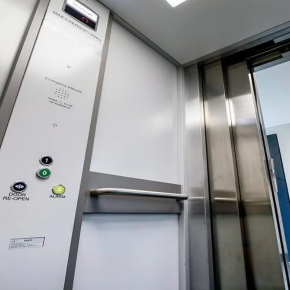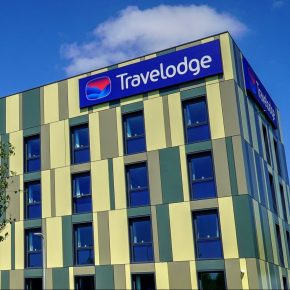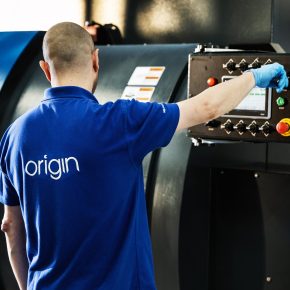
Stannah’s quick guide to LRV specification and lifts
Lift design is ever-evolving and, without a doubt, specifying the right surface or object reflectance for your lift cabin finishes is key to designing a building that everyone can use – especially the visually impaired. Stannah talk more about LRV and lifts…
What is LRV?
It is important not to confuse light reflectance value (LRV) with colour intensity. LRV measures how much light a colour reflects and absorbs. It runs from 0% to 100%.
The assumption is that zero is an absolute black and 100% is a perfectly reflective white. Approximately speaking, the average blackest black has an LRV of 5% and the whitest white at 85%. Some yellows can measure up into the ’80s or 90s as well.
Why is LRV important?
For the majority of people, colour differences can provide adequate visual contrast. However, this is not the case for all building users. People with vision impairments often distinguish surfaces by the amount of light they reflect. The greater the difference between LRV and adjacent materials, the more likely the difference in surfaces will be identifiable, for example enabling the visually impaired to identify controls or distinguish lift car doors from adjacent walls.
Examples of where visual contrast and LRV difference between finishes can be required in lifts:
– The call panel should be easily distinguishable from its background.
– The floor area outside the lift and lift car doors should be visually distinguishable from the adjoining walls.
– Lighting and surfaces within the lift car should minimise glare, reflection, confusing shadows and pools of light and dark.
– Lights adjacent to control panels are not recommended because they could make it difficult for people to read controls.
What do the building regulations and design guidance say?
In terms of building regulations, and where compliance with Technical Guidance Document Part M 2010 is necessary, it is important to ensure that elements of a building do not pose a risk to people with vision impairments.
References for LRV tend to be in Building standards and design guidelines rather than specific lift standards. Below are some of the references to contrast and LRV that you should consider.
Part M – General guidance
Contrast visually, when used to indicate the visual perception of one element of the building, or fitting within the building against another means that the difference in light reflective value between the two surfaces is greater than 30 points. Where illuminance on surface is greater than 200 lux, a difference in light reflective value should be a minimum of 20 points. Where door opening furniture projects beyond the face of the door or otherwise creates enhance differentiation and shade a minimum difference in LRV of 15 points is considered adequate (2)
General requirements for lifting devices – Design Considerations
3.28d – All call and control buttons contrast visually with the surrounding face place, and the face plate similarly contrasts with the surface on which it is mounted.
3.28e – The floor of the lifting device should not be of a dark colour and should have frictionless qualities similar to or higher than, the floor of the landing;
Technical Handbook (Scotland)
States that lift doors, handrails and controls should contrast visually with surrounding surfaces (no reference to actual values).
BS 8300-2:2016
Advises doors and floors to contrast visually with their surroundings – no reference to values.
Lifts Standards
The only lift standard citing LRV are passenger lift standards (> 0.15m/s) within BS EN 81-70:2018 – Accessibility to lifts for persons, including persons with disability. Here the onus is on the customer to comply with lift identification to the background, and faceplates to its surrounding. Typically, as standard, all our passenger lift controls comply with BS EN 81-70.
How Stannah can help with colour specification
Increasingly, Stannah are seeing more requests for colour considerations as awareness grows over visual impairments and increasing awareness of how dementia affects visual perception.
The company states LRV on its finishes for its people moving lifts for specifiers to make informed choices on finishes to help make lift specifications easier.
Visit Supplier's page
Latest news

21st November 2024
Altro distils style and performance at English Spirit
English Spirit Distillery has used an extensive package of Altro products front and back of house, in their new visitor centre café, shop and viewing area for the working distillery.
Posted in Articles, Bathrooms, Bedrooms & Washrooms, Building Industry News, Building Products & Structures, Building Systems, Case Studies, Floors, Interior Design & Construction, Interiors, Kitchens, Restoration & Refurbishment, Retrofit & Renovation, Timber Buildings and Timber Products, Walls
21st November 2024
Abloy UK creates bespoke locking solution for Secure Information Boxes
Abloy UK has supplied The Safety Letterbox Company Ltd with a bespoke Sentry CL811 Camlock for use in its Secure Information Boxes, assisting life safety and complying with new regulations and legislation for high rise buildings.
Posted in Access Control & Door Entry Systems, Architectural Ironmongery, Articles, Building Industry News, Building Products & Structures, Building Regulations & Accreditations, Building Services, Case Studies, Facility Management & Building Services, Health & Safety, Posts, Restoration & Refurbishment, Retrofit & Renovation, Security and Fire Protection
20th November 2024
CUPA: CUPACLAD enhances hotel aesthetics with a creative natural slate façade
Situated at the northern edge of a newly developed retail park near Bristol, the Abbey Wood Travelodge was conceived as part of the company’s new Budget-Luxe line of hotels – it features CUPACLAD, from CUPA PIZARRAS.
Posted in Articles, Building Industry News, Building Products & Structures, Building Systems, Case Studies, Cladding, Concrete, Cement, Admixtures, Facades, Posts, Restoration & Refurbishment, Retrofit & Renovation, Walls
20th November 2024
Origin launches in-house powder coating facility
Origin’s latest investment is set to redefine industry standards as it launches its own in-house powder coating facility.
Posted in Aluminium Products, Articles, Building Industry News, Building Products & Structures, Building Systems, Doors, Glass, Glazing, Innovations & New Products, Paints, Coatings & Finishes, Restoration & Refurbishment, Retrofit & Renovation, Site Preparation, Windows
 Sign up:
Sign up: /Stannah-LRV-1.jpg?width=349&name=Stannah-LRV-1.jpg)